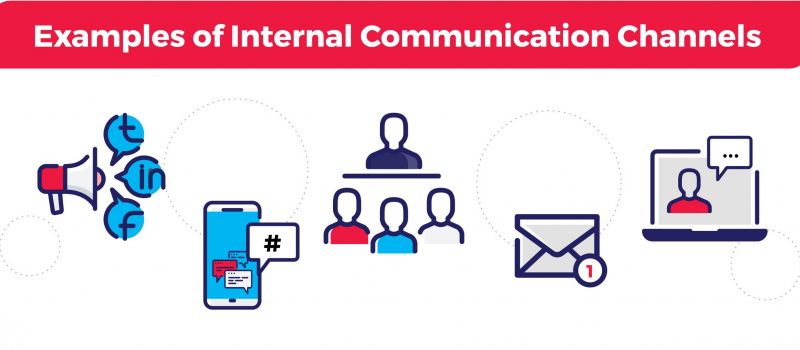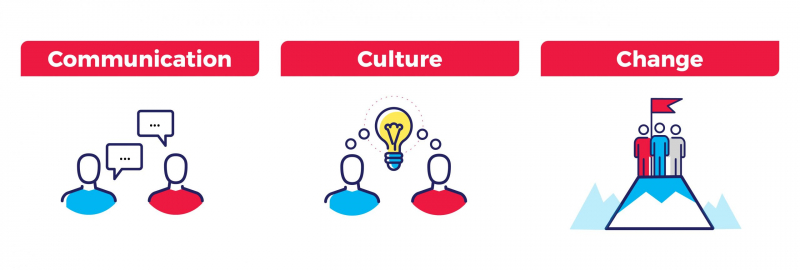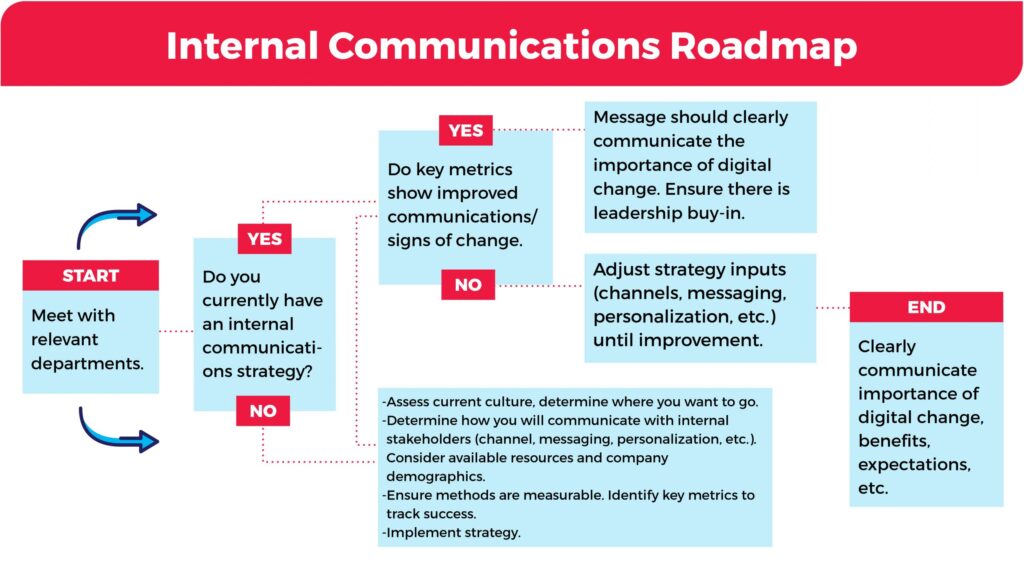Introduction
Digital transformation can be defined as change associated with the application of technology. Digital transformation affects every area of business, yet not all organizations take it seriously.
Since 2000, over 50 percent of Fortune 500 companies have disappeared due to various reasons that hindered their digital transformation. In the past year alone, hundreds of major retailers filed for bankruptcy, including Hertz, Neiman Marcus, Centric Brands.
To remain competitive in today’s market, companies not only have to determine what changes need to be made but also how to manage the change. For some companies, managing change has become a key source of competitiveness that can’t be easily matched.
To facilitate change, effective communication is the key.

How do organizations communicate?
There are two main groups that organizations communicate their message to, external stakeholders and internal stakeholders.
External stakeholders are users and customers of products or services and often have significant power in shaping how organizations operate and develop. For example, if external stakeholders don’t like a given product, they will simply not buy the product. Every organization has a responsibility to ensure they are communicating effectively with external stakeholders by highlighting things such as benefits of product/service use.
“Communication leads to community – that is, to understanding, intimacy, and the mutual valuing that was previously lacking.”
-Rollo May
Internal stakeholders are associated with an organization. This can include employees, partners, etc. Unlike external stakeholders who influence the way organizations change, internal stakeholders are responsible for driving business results and acting on change. Internal stakeholders are the base of the organization, so it is important that companies spend an equal (or greater) amount of time communicating with them to potentially unlock greater success with external efforts.
For organizations beginning their digital transformation journey, effective internal communication is crucial to determining the rate of change of an organization.
What is internal communications?
The practice and study of communication that enables employee engagement and helps deliver change is often referred to as Internal communications (IC). For some organizations, internal communications is the responsibility of HR and comes in the form of information sharing from the time an employee is interviewed to the time he/she leaves the company. Any questions or concerns from an employee would be directed to HR for a response. For other organizations, internal communications is managed by a communications team that relay messages from senior leaders to employees and from employees back to senior leaders. No matter how an organization formally assigns internal communications duties, it is everyone’s responsibility to ensure that there is effective internal communication within an organization.

There are many channels used by organizations that foster internal communication. As technology capabilities increase, so does the list of internal communication tools that an organization can use.
Common examples of internal communication channels include:
- Email: Most companies use email for internal communication needs because of its ability to reach many employees and its ease of use.
- Meetings (face-to-face): Staff meetings are vital to organizations of all sizes because issues raised are often crucial. When meetings are not properly managed, resources, such as time and money, are wasted.
- Intranet: A modern intranet can help increase employee engagement if it is user-friendly and shares relevant information and resources. Unfortunately, as changes to an intranet requires extra resources, many organizations have outdated intranets with low usage rates.
- Social Media: Employees use social media outside of work, so it only makes sense for organizations to create internal social media channels to help facilitate communication. Examples of social media channels include LinkedIn, Twitter, and Facebook.
- Displays: Displays such as posters, flyers, and bulletin boards, are traditional communication tools that are visible and cost-effective. To modernize traditional displays and reduce paper waste, organizations are adopting digital displays and placing screens strategically to maximize impact.
- Internal Messaging: There are many different internal messaging providers, each with their pros and cons and unique features. Examples include Slack, Skype, and HipChat.
- Effective internal communications contributes to the growth of the organization
- Effective internal communications promotes knowledge sharing at the workplace
- Effective internal communications benefits the end user
How internal communications impacts culture and change

As mentioned earlier, there are a lot of benefits to effective communication. However, the most important outcome of effective communication is that it defines workplace culture. When employees interact, they are actively building and reinforcing the company culture. It is important that senior and influential employees model the right kinds of behaviour and set a good example for others. Once a culture is established, internal stakeholders work together, with the same vision and goals, towards change.
Creating an internal communications strategy for digital change
As internal communication builds and reinforces company culture, it is important for organizations preparing for their digital transformation to communicate the importance and need for digital change with internal stakeholders. Doing so will create a digital culture that will help speed up the digital transformation of the organization.
When organizations try to adjust their current culture, it is important to consider the following:
Assess your current internal communications strategy
- Where are you now?
If your organization currently has an internal communications strategy, it is important to understand how your strategy has performed. Identify strengths and weaknesses and get a better understanding of how your current internal communications practices (messages, channels, results) have influenced company culture.
- Where do you want to be?
The main objective of your internal communications strategy is to create a digital culture that will aid with digital transformation. Every organization has a different level of digital readiness so it is important to ensure that the objective is attainable given the organization’s current culture. Organizations unsure of where they want to be can compare themselves to their peers.
- How are you going to get there?
A detailed plan that outlines the selection of message, tone, channel, etc. needed to communicate the change.
Identify key metrics to track success
It’s important to identify key metrics to determine if your plan is successful. By skipping this step, organizations can’t effectively manage their internal communications efforts. In cases where an organization lacks the resources or expertise to measure internal communications efforts, there are numerous internal communications tools that can be used.

Iterate your internal communications strategy
Organizations should adjust their internal communications strategy according to changes in key metrics until the objective is met.
Things to consider for your internal communications strategy
The success of your internal communications strategy is dependent on various components such as:
Personalization
It’s important to keep in mind that not every employee is the same. Sending employees an irrelevant message will not lead to the growth of the company, sharing of knowledge, or benefit the end user. To better personalize messages, the organization can segment and target their employees using information housed by the HR department.
Successful organizations don’t send out the same marketing message to external stakeholders in their database, so organizations shouldn’t do the same for internal stakeholders.
Leadership buy-in
Employees often follow leadership’s example, so it is important to get early buy-in from key influential players. Another benefit of leadership buy-in is that it may lead to additional funding to help with internal communications efforts.
Channel selection
It’s important to select the right medium for your message. Using technology that matches the habits of employees outside of work allows the organization to better adapt to external changes and may shape new habits and motivation from employees. It is important to note that while digital communication (email, intranet, etc.) is utilized most frequently, there are other channels, such as displays, that can be used to deliver and reinforce key messages.
A great channel has the following traits:
- Reach: Communication must be able to reach all personnel, even those whose responsibilities do not involve computer/email use.
- Delivery time: Communication must be timely. If your channel cannot deliver important information in a timely manner, there could be negative consequences for the company.
- Interaction: Successful communication is a two-way street. People need to be able to express themselves so that their ideas and concerns can shape the way the organization operates.
- Analytics: With advancements in data collection, it is easier to determine how many employees receive and open internal communications messages by channel. This information can be extremely useful in determining how to better allocate resources.
- Costs: Each internal communications channel comes with an associated cost. It is important to weigh the benefits with the costs of each before deciding if the channel is appropriate for your organization.
Clarity of message
The message being communicated must be clear for employees to act. Not only does the message have to align with the goals and objectives of the organization, but it also must demonstrate how an employee is connected to goals and objectives of the organization and include the responsibilities he/she must take.
Summary
With the world changing before our eyes, it’s important that all organizations keep up with change or die. Change may be easier for smaller organizations with fewer employees, but as an organization grows, change can be extremely difficult. The key to change is effective internal communication. Internal communication builds and reinforces culture that can lead to change. Organizations beginning their digital transformation journey must ensure that their internal communications strategy will foster a digital culture and speed up the change process.
To determine how your internal communications strategy can lead to digital change, refer to the roadmap below for next steps.
